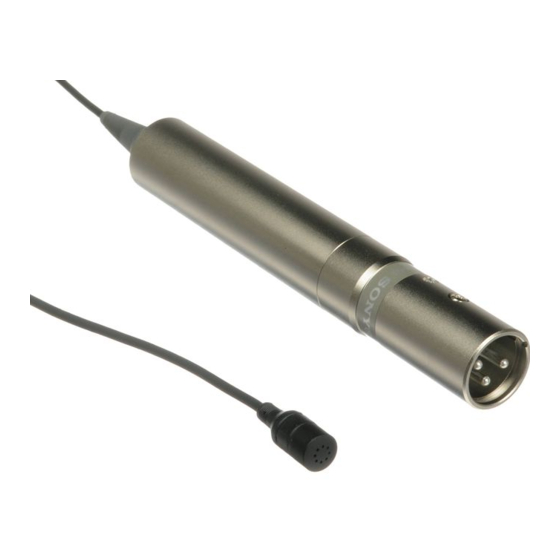
Sony ECM-44B - Electret Condenser Microphone Manual
- Operating instructions (2 pages)
Advertisement

Frequency response

Directivity


For the customers in Europe
This product is intended for use in the following
Electromagnetic Environments: E1 (residential), E2 (commercial and light industrial), E3 (urban outdoors), E4 (controlled EMC environment, ex. TV studio).

The electromagnetic fields at the specific frequencies may influence the sound of this unit.
FEATURES
- Compact and lightweight design allows unobtrusive microphone use.
- Omni-directional directivity allows clear sound pickup from any direction.
- Powering system using an internal battery.
- Easy handling carrying case.
PRECAUTIONS
- The microphone should never be dropped or subjected to any excessive shock.
- Keep the microphone away from extremely high temperatures (above 60°C or 140°F)
- If the microphone is used too close to speakers, the sound from the speakers will be picked up and produce a howling effect (i.e., acoustic feedback). To prevent howling, avoid facing the microphone toward the speakers and maintain as much distance from the speakers as possible.
- Microphone and recording instruments should be turned on 10 minutes before they are actually used. This assures stable performance of the microphones and instruments.
PARTS IDENTIFICATION

Supplied accessories

Wind screen

Microphone holder
BATTERY OPERATION
- Open the battery compartment by turning the sleeve counterclockwise.
- Insert an IEC designation R6 or LR6 (size AA) battery into the battery compartment.
![Sony - ECM-44B - BATTERY OPERATION BATTERY OPERATION]()
- Close the compartment by turning the sleeve clockwise. Be sure to close the sleeve firmly, otherwise malfunction or noise may occur due to the loose fit.

- If the microphone is not to be used for a long time, remove the battery to avoid any possibility of corrosion.
- In case of battery leakage, wipe off any deposit in the battery compartment.
- Battery life depends on the battery type being used. Refer to the "Battery life" in "Specifications" below. When the battery is exhausted, sensitivity will be decreased and distortion will be heard. When this occurs, replace with a new battery.
CONNECTIONS
The output connector of the microphone is the XLR3-12C type. Connect the microphone plug to the microphone input of a mixer or a tape recorder. The microphone cable is 3 m (10 feet) long.
If a longer cable is necessary, an extention cable up to 200 m (660 feet) may be used without affecting sound quality or performance. Use a cable with an XLR-3-11C connector at one end and an appropriate plug at the other end which matches the input equipment.

If cable connector connection is necessary, note that there are two basic types of connections, balanced to ground and unbalanced to ground, and solder connections carefully. Poor soldering may cause hum pick up.
MORE ABOUT MICROPHONE USE
- To reduce the effect of wind or breath noise, attach the supplied wind screen to the microphone.
- The supplied microphone holder is convenient for attaching the microphone to clothing. Be careful not to cover the microphone head.
![Sony - ECM-44B - MORE ABOUT MICROPHONE USE MORE ABOUT MICROPHONE USE]()
SPECIFICATIONS
General
Type: Electret condenser microphone
Power supply: IEC designation R6 or LR6 battery (size AA)
Microphone output terminal: XLR-3-12C type
Microphone cable: Approx. 2.3 mm dia., 3 m long (3/32 inch dia., 10 feet long)
Dimensions: Microphone: Approx. 8.5 mm dia. ×14.5 mm (11/32 dia. × 19/32 inches)
Power supply section: Approx. 20 mm dia. × 126 mm (13/16 dia. × 5 inches)
Mass: Microphone: Approx. 2 g (0.07 oz)
Power supply section: Approx. 120 g (4.2 oz) (including cable, not including battery)
Supplied accessories:
Storage case (1)
Microphone holder (1)
Wind screen (1)
Operating Instructions (1)
Warranty booklet (1)
Performance
Frequency range: 40 Hz–15,000 Hz
Directivity: Omni-directional
Output impedance: 250 ohms ±20% (1 kHz), balanced
Sensitivity (typ.): –53 dB (2.2 mV) (0 dB = 1 V/Pa, 1 kHz)
Signal-to-noise ratio: 62 dB (typ.) (IEC 179 A-weighted, 1 kHz, 1 Pa)
Inherent noise: 32 dB SPL (typ.) (0 dB = 2 × 10–5 Pa)
Wind noise*1: Less than 40 dB SPL (with wind screen)
Maximum input sound pressure level *2: 122 dB SPL (typ.)
Dynamic range: 90 dB (typ.)
Operating temperature: 0°C to 60°C (32°F to 140°F)
Storage temperature: –20°C to +60°C (–4°F to +140°F)
*1 Value derived by applying a wind velocity of 2 m/sec. (6.6 ft./sec.) to the microphone from all directions, and converting the mean value to the equivalent input sound pressure level (0 dB = 2 × 10–5 Pa).
*2 Value derived by taking the input level at which 1% waveform distortion occurs with a 1-kHz microphone output signal, and converting it to the equivalent input sound pressure level (0 dB = 2 × 10–5 Pa).
Power requirements
Normal operating voltage: 1.5 V DC
Minimum operating voltage: Approx. 1.1 V DC
Current drain: Less than 0.2 mA (1.5 V DC)
Battery life: R6 manganese battery: Approx. 5,000 hours
LR6 alkaline battery: Approx. 6,000 hours
Design and specifications subject to change without notice.

Always verify that the unit is operating properly before use. SONY WILL NOT BE LIABLE FOR DAMAGES OF ANY KIND INCLUDING, BUT NOT LIMITED TO, COMPENSATION OR REIMBURSEMENT ON ACCOUNT OF THE LOSS OF PRESENT OR PROSPECTIVE PROFITS DUE TO FAILURE OF THIS UNIT, EITHER DURING THE WARRANTY
PERIOD OR AFTER EXPIRATION OF THE WARRANTY, OR FOR ANY OTHER REASON WHATSOEVER.

Documents / ResourcesDownload manual
Here you can download full pdf version of manual, it may contain additional safety instructions, warranty information, FCC rules, etc.
Download Sony ECM-44B - Electret Condenser Microphone Manual
Advertisement
Thank you! Your question has been received!














Need Assistance?
Do you have a question about the ECM-44B that isn't answered in the manual? Leave your question here.